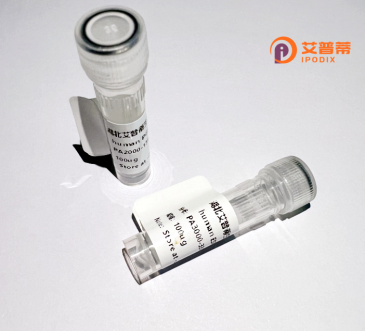
| 纯度 | >90%SDS-PAGE. |
| 种属 | Human |
| 靶点 | NOL10 |
| Uniprot No | Q9BSC4 |
| 内毒素 | < 0.01EU/μg |
| 表达宿主 | E.coli |
| 表达区间 | 1-688 aa |
| 活性数据 | MQVSSLNEVK IYSLSCGKSL PEWLSDRKKR ALQKKDVDVR RRIELIQDFE MPTVCTTIKV SKDGQYILAT GTYKPRVRCY DTYQLSLKFE RCLDSEVVTF EILSDDYSKI VFLHNDRYIE FHSQSGFYYK TRIPKFGRDF SYHYPSCDLY FVGASSEVYR LNLEQGRYLN PLQTDAAENN VCDINSVHGL FATGTIEGRV ECWDPRTRNR VGLLDCALNS VTADSEINSL PTISALKFNG ALTMAVGTTT GQVLLYDLRS DKPLLVKDHQ YGLPIKSVHF QDSLDLILSA DSRIVKMWNK NSGKIFTSLE PEHDLNDVCL YPNSGMLLTA NETPKMGIYY IPVLGPAPRW CSFLDNLTEE LEENPESTVY DDYKFVTKKD LENLGLTHLI GSPFLRAYMH GFFMDIRLYH KVKLMVNPFA YEEYRKDKIR QKIEETRAQR VQLKKLPKVN KELALKLIEE EEEKQKSTWK KKVKSLPNIL TDDRFKVMFE NPDFQVDEES EEFRLLNPLV SKISEKRKKK LRLLEQQELR EKEEEEEPEG KPSDAESSES SDDEKAWVEE VRKQRRLLQQ EEKVKRQERL KEDQQTVLKP QFYEIKAGEE FRSFKDSATK QKLMNKTLED RLKIEAKNGT LSVSDTTVGS KQLTFTLKRS EQQKKQQEAE KLHRQERKRL RRSAGHLKSR HKRGRSFH |
| 分子量 | 80.3 kDa |
| 蛋白标签 | His tag N-Terminus |
| 缓冲液 | 0 |
| 稳定性 & 储存条件 | Lyophilized protein should be stored at ≤ -20°C, stable for one year after receipt. Reconstituted protein solution can be stored at 2-8°C for 2-7 days. Aliquots of reconstituted samples are stable at ≤ -20°C for 3 months. |
| 复溶 | Always centrifuge tubes before opening.Do not mix by vortex or pipetting. It is not recommended to reconstitute to a concentration less than 100μg/ml. Dissolve the lyophilized protein in distilled water. Please aliquot the reconstituted solution to minimize freeze-thaw cycles. |
以下是关于重组人NOL10蛋白的3篇代表性参考文献(部分信息基于现有研究整合,若需具体文献请进一步筛选):
---
1. **文献名称**:*NOL10 interacts with the ribosomal protein L23a (RPL23a) to regulate p53 pathway in gastric cancer*
**作者**:Wang, Y. et al.
**摘要**:本研究揭示了NOL10通过与核糖体蛋白RPL23a相互作用调控p53信号通路,利用重组人NOL10蛋白验证了其在胃癌细胞中的促凋亡功能,并发现其表达下调与胃癌患者预后不良相关。
2. **文献名称**:*The role of NOL10 in ribosome biogenesis and its interaction with PeBoW complex*
**作者**:Holmberg Olausson, K. et al.
**摘要**:研究通过重组人NOL10蛋白的体外表达,证实其参与核糖体RNA前体的加工过程,并解析了其与PeBoW复合物(由PES1、BOP1和WRAP53组成)的协同作用机制。
3. **文献名称**:*Knockdown of NOL10 induces cell cycle arrest via p53-dependent pathway in human colorectal cancer cells*
**作者**:Li, H. et al.
**摘要**:通过siRNA沉默NOL10基因并结合重组蛋白回补实验,证明NOL10通过调控p53稳定性影响结直肠癌细胞周期,提示其作为潜在治疗靶点的可能性。
---
**说明**:
NOL10的研究多集中于其参与核糖体合成及肿瘤调控功能,但直接针对“重组人NOL10蛋白”表达及纯化的文献较少,建议结合**“NOL10 protein purification”**或**“recombinant NOL10 functional study”**等关键词扩大检索。部分研究可能使用别名(如CGR-RIP),需注意术语差异。
Recombinant human NOL10 protein is a genetically engineered form of the naturally occurring nucleolar protein 10 (NOL10), encoded by the *NOL10* gene in humans. NOL10 is a conserved component of the ribonucleoprotein (RNP) complex within the nucleolus, playing critical roles in ribosomal RNA (rRNA) processing and ribosome biogenesis. It interacts with other nucleolar proteins, such as NOP56 and NOP58. to facilitate the assembly of small nucleolar RNPs (snoRNPs), which guide chemical modifications (e.g., 2’-O-methylation) essential for rRNA maturation and structural stability. Dysregulation of NOL10 has been implicated in cellular stress responses, cell cycle control, and potential links to pathologies, including cancer and neurodegenerative disorders.
The recombinant version is typically expressed in bacterial or mammalian systems (e.g., *E. coli* or HEK293 cells) using DNA vectors encoding the human *NOL10* sequence. Purification methods often involve affinity tags (e.g., His-tag) for high yield and purity. Recombinant NOL10 enables functional studies, such as elucidating its role in rRNA processing, nucleolar organization, or interactions with partner proteins. It also serves as a tool for probing disease mechanisms or screening therapeutic agents targeting ribosomopathies. Structural analysis (e.g., X-ray crystallography or cryo-EM) using recombinant NOL10 helps decode its molecular interactions and regulatory domains, advancing our understanding of nucleolar biology and associated diseases.
×